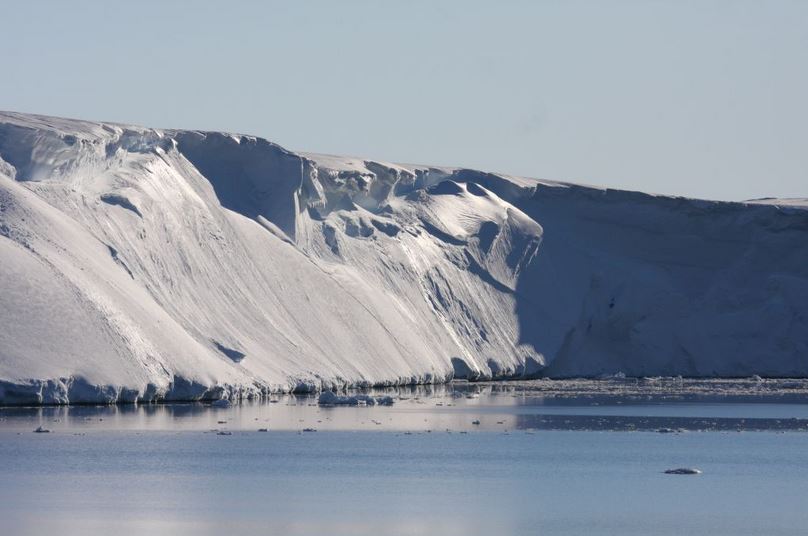A valley underneath the massive Totten Glacier in East Antarctica delivers warm water to the base of the ice, causing considerable melting, which will contribute to raising sea levels globally, a group of scientists from the US, UK, Australia and France have warned.
This intrusion of warm sea water is making the rapidly-changing Totten Glacier melt and thin at an even faster rate. The glacier drains enough ice to raise the sea level worldwide by 3.5 metres (11.5 feet).
The Totten Glacier is one of the principal outlets for the East Antarctic Ice Sheet, which is the biggest mass of ice on our planet and covers 98% of the continent.

The Totten Glacier is 1,100 km long and 750 km wide. (Image: Australian Antarctic Division)
Totten Glacier could represent a major component in rising sea levels caused by climate change and warmer oceans, with ocean levels forecast to rise by approximately one metre (33 inches) per century.
Scientists from the University of Texas at Austin, the University of Tasmania, the Australian Antarctic Division, the University of Western Australia, CSIRO Oceans and Atmosphere Flagship (Australia), CNRS-LEGOS (France), the Jet Propulsion Laboratory (USA), and Imperial College London, published their findings in the academic journal Nature Geoscience (citation below).
This study follows findings earlier this year from a marine science voyage to the Totten Glacier, which detected glacial melt water. However, scientists were not able to establish how the deep, warm sea water was getting underneath the glacier.
Melting process is probably irreversible
Co-author Professor Martin Siegert, Co-Director of the Grantham Institute at Imperial College London, said:
“It’s only one glacier, but it’s changing now and it is significant for sea levels globally. The 3.5 metre rise may take several centuries to complete, but now the process has started it is likely irreversible.”
“This is another example of how human-induced climate change could be triggering major changes with knock-on impacts that will be felt globally.”
Scientists had thought the East Antarctic Ice Sheet was surrounded by cooler water, thus making it relatively stable compared to the smaller West Antarctic Sheet, which annually is losing over 150 cubic kilometres of ice.

A map showing the recently discovered landscape underneath Totten Glacier. Orange arrows indicate seafloor valleys deep enough to allow warm water to enter beneath the floating ice that likely explain the glacier’s extreme thinning. The solid orange arrow leads to the deeper of the two gateways, a 3 mile-wide seafloor valley previously thought to be completely cut off from the ocean. (Image: Jamin Greenbaum)
However, according to data gathered from satellites, the Totten Glacier has also been thinning significantly. To find out why, the scientists surveyed the area.
With the use of radar and other geophysical techniques, the international team obtained a map of the topographical landscape underlying the Totten Glacier where it met the sea. They discovered there is a 5 km-wide (3 mile-wide) valley running underneath the glacier that can let warm ocean water reach the ice base.
On thin ice – literally
The ice located at the margins of ice sheets are able to float on the sea, but inland ice is ‘grounded’ and in contact with the bedrock.
The valley they have just discovered allows warm ocean water to flow underneath the region of floating ice, exposing the ice sheet’s grounded edge to high temperature, which leads to glacier melting.
The authors say that destabilization of the Totten Glacier could make more ice inland vulnerable to change.
Prof. Siegert said:
“Once a certain region starts to change, the implications for the connected ice are potentially significant. We are using computer modelling to understand whether changes in Totten Glacier could lead to changes in both adjacent and more distant places in Antarctica.”
“While this work needs to be undertaken, the change at Totten Glacier itself is significant and concerning.”
Dr. Jason Roberts, a glaciologist at the Australian Antarctic Division, said:
“The Totten Glacier is the most rapidly thinning glacier in East Antarctica and this melt has the potential to drive substantial regional ice loss.”
“The study identifies a direct pathway for warm ocean water to reach under the glacier; a likely reason for the observed thinning.”
There is still much we do not know about the landscapes beneath the Antarctic ice. The research team says it plans to map even more remote regions in order to understand the dynamics of the continent.
“These include two ‘poles of ignorance’ – spots on Antarctica where you can stand and be at least 200km from the nearest data point relating to the continent beneath the ice,” they wrote.
The research was funded by NASA’s Operation IceBridge, the US NSF, the Australian Antarctic Division, NERC (UK), and the G. Unger Vetlesen Foundation.
Citation: “Ocean access to a cavity beneath Totten Glacier in East Antarctica,” J. S. Greenbaum, D. D. Blankenship, D. A. Young, T. G. Richter, J. L. Roberts, A. R. A. Aitken, B. Legresy, D. M. Schroeder, R. C.Warner, T. D. van Ommen, and M. J. Siegert. Nature Geoscience. Published Monday 16 March, 2015. DOI: 10.1038/ngeo2388.
Video – How Antarctica is changing

